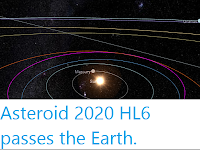Asteroid 2000 KA passed by the Earth at a distance of about 3 397 000
km (8.85 times the average distance between the Earth and the Moon, or 2.27% of the distance between the Earth and the Sun), at about 11.20 am
GMT on Tuesday 12 May 2020. There was no danger of
the asteroid hitting us, though were it to do so it would have
presented a considerable threat. 2000 KA has an estimated
equivalent
diameter of 86-270 m (i.e. it is estimated that a spherical object with
the same volume would be 86-270 m in diameter), and an object at the
upper end of this range would be predicted to be capable of passing
through the Earth's
atmosphere relatively intact, impacting the ground directly with an
explosion that would be 35 000 times as powerful as the
Hiroshima
bomb. Such an impact would result in an impact crater almost 4 km in
diameter
and devastation on a global scale, as well as climatic effects that
would last decades or even centuries.
180 second image of 2000 KA taken with the Elena Planetwave 17" Telescope
at Ceccano
in Italy on 12 May 2020. The asteroid is the small point at the
centre of the image, indicated by the white arrow, the longer lines are
stars, their elongation being
caused by the telescope tracking the asteroid over the length of the
exposure. Gianluca Masi/Virtual Telescope.
2000 KA was discovered on 22 May 2000 by the Lowell Observatory Near-Earth-Object Search, at Anderson Mesa Station, near Flagstaff, Arizona. The
designation 2000 KA
implies that it was the first asteroid (asteroid A)
discovered in the second half of May 2000 (period 2000 K - the
year being split into 24 half-months represented by letters).
The calculated orbit of 2000 KA. JPL Small Body Database Browser.
2000 KA has an 561 day (1.54 year) orbital period and an eccentric orbit
tilted at an angle of 0.27° to the plane of the Solar System, which
takes it from 0.72 AU from the Sun (i.e. 72% of the the average distance at
which the Earth orbits the Sun, and slightly outside the orbit of Venus) to 1.95 AU from the Sun (i.e. 195% of
the
average distance at which the Earth orbits the Sun, somewhat more than the distance at which Mars orbits). It is therefore
classed as an
Apollo Group Asteroid (an asteroid that is on average further from the
Sun than the Earth, but which does get closer). This means that close
encounters between the asteroid and Earth are extremely common, with the
last having occurred in May 2017 and the next predicted
in June 2023. As an asteroid probably larger than 150 m in diameter
that occasionally comes within 0.05 AU of the Earth, 2000 KA is also
classified as a Potentially Hazardous Asteroid. 2000 KA also has occasional close encounters with the planets Mars, with the last having happened in November 1956, and the next predicted for August 2046, and Venus, which it is next expected to pass in June 2098.
See also...
Follow Sciency Thoughts on Facebook.








